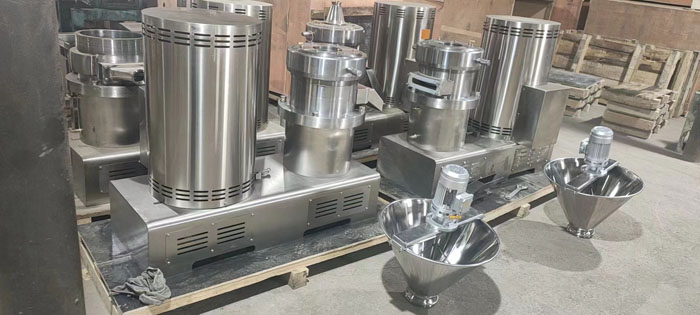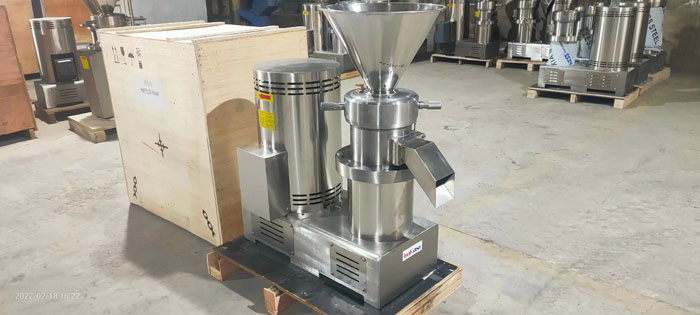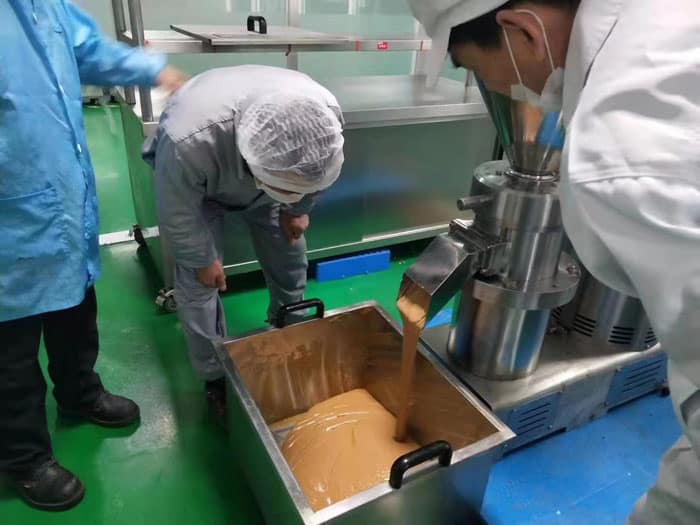Industrial colloid mill for wet grinding
What is colloid mill?
Colloid mill is a machine that is used to processing fluid materials. It integrates various mechanical properties such as homogenizers, ball mills, shearing machines, mixers, etc., and has functions such as ultra-fine grinding, dispersion emulsification, homogenization, and mixing. After processing, the material has a particle size of 2-50 microns and a homogeneity of over 90%, making it an ideal equipment for ultra fine particle processing.
Colloid mills work on the rotor-stator principle: a rotor turns at high speeds (2000–18000 RPM) and creates a high level of hydraulic shear that breaks down the material. Colloid mills are suitable for wet grinding of various materials, such as spices, herbs, grains, nuts, seeds, resins, pigments, waxes, and chemicals.

Industrial colloid mill for wet grinding working principle
The working principle of colloid mill is shearing, grinding, and high-speed stirring. Grinding relies on the relative motion of two tooth surfaces, with one rotating at high speed and the other stationary in the base, enabling the material to exert great shear and friction forces through the tooth surfaces. At the same time, under the action of complex forces such as high-frequency vibration and high-speed vortices, the material is effectively dispersed, emulsified, crushed, and homogenized.
Industrial colloid mill for wet grinding advantages
Colloid mills have several advantages over other types of grinding machines, such as:
- It can produce very fine particles, down to approximately 1 μm, which are more stable and resistant to separation.
- It can handle high viscosity and temperature-sensitive materials, as the wet grinding process is fast and does not generate much heat.
- It can easily adjust the gap between the rotor and stator, allowing for precise control over the final particle size. This adjustability is essential in meeting different specific product requirements.
- Low maintenance, easy to clean.




Industrial colloid mill for wet grinding application
- Food industry: aloe, sesame paste, nut butter, fruit tea, ice cream, moon cake filling stuff, cream, jam, peanut milk, peanut butter, protein milk, soy milk, dairy products, essence, various drinks, bone paste for pet food etc.
- Chemical industry: paints, pigments, dyes, ubricants, greases, emulsified asphalt, adhesives, detergents, plastics, fiberglass, leather, emulsions, etc
- Daily chemical products: toothpaste, detergent, shampoo, shoe polish, high-end cosmetics, shower essence, soap, balm, etc
- Pharmaceutical industry: syrup, nutrient solution, traditional Chinese patent medicines and simple preparations, paste medicine, biological products, cod liver oil, pollen, royal jelly, vaccine, various ointments, various oral liquids, injections, intravenous drip, etc
- Construction industry: various coatings. Including interior and exterior wall coatings, anti-corrosion and waterproof coatings, cold porcelain coatings, colorful coatings, ceramic glazes, etc
- Other industries: plastic industry, textile industry, papermaking industry, nanomaterials and other industries require high-quality and environmentally friendly production.
Industrial colloid mill for wet grinding technical data
| Model | JMS50 | JMS80 | JMS110 | JMS130 | JMS180 | JMS240 | JMS300 |
|---|---|---|---|---|---|---|---|
| Fineness | 50-100mesh | 50-100mesh | 100-200mesh | 100-200mesh | 100-200mesh | 100-200mesh | 100-200mesh |
| Capacity | 5-30kg/h | 100-500kg/h | 0.3-1.2t/h | 0.5-2t/h | 0.8-6t/h | 4-15t/h | 6-20t/h |
| Power | 1.5kw | 4kw | 7.5kw | 11kw | 18.5kw | 45kw | 75kw |
| Dimension | 530*260*580mm | 600*410*930mm | 700*430*1000mm | 990*440*1100mm | 990*490*1100mm | 1320*500*1280mm | 1440*630*1420mm |
| Weight | 50kg | 150kg | 175kg | 285kg | 330kg | 920kg | 1600kg |
How to choose the right colloid mill for wet grinding?
Choosing the right colloid mill for wet grinding depends on several factors, such as the size, shape, and properties of the material, the desired particle size, the capacity, and the budget.
Different types of colloid mills have different features and specifications, such as speed, efficiency, noise, maintenance, and safety.
It is advisable to consult a professional engineer or us as a professional supplier of powder processing equipment for advice.
Customized colloid mill for option:
- Vertical or horizontal design
- Feeding inlet: pump, hopper, screw feeder
- Multiple fineness stators and rotors
- Grinding spacing adjustment
- Water cooling system
- Fixed or movable
- Circulating pump
- Machine material: 2Cr13, SUS304, SUS316
How to use colloid mill for wet grinding?
To use a colloid mill for wet grinding, you need to follow these steps:
- Check the cleanliness of the colloid mill and the integrity of all components.
- Check the clearance between the fixed teeth and the rotating teeth to ensure that the clearance is not in the minimum state. Clockwise (viewed from above) indicates a decrease, while counterclockwise indicates an increase.
- Turn on the power supply。
- Rinse the pipeline with clean water. When the effluent is clear, add materials. Flow a small amount of material into the feeding hopper, adjust the gap adjustment sleeve, and determine the grinding gap (be careful not to get stuck)
- After the grinding process is completed, adjust the gap to the maximum and clean the pipeline with purified water heated at 90 ℃ or above for 5 minutes. After the remaining materials and hot water are drained, the machine can be stopped.
- Cut off the power and clean the surroundings of the equipment.
How to maintain and clean the colloid mill for wet grinding?
In order to ensure the long-term operation of the colloid mill, in addition to daily cleaning and lubrication, it is also necessary to pay attention to the following points:
- Regularly inspect equipment for malfunctions and wear
The key parts of the colloid mill include grinding discs, stator, rotator, motors, etc. These components are likely to wear out after long-term use, affecting the normal operation of the equipment. Therefore, it is necessary to regularly check the normal operation of all components of the equipment, and replace severely worn parts in a timely manner to ensure the long-term operation of the colloid mill.
2. Pay attention to lubrication and maintenance
During the operation of the equipment, the grinding disc and teeth will generate significant friction. If not lubricated, it is easy to cause overheating and wear of the equipment, affecting the service life of the colloid mill. Therefore, it is necessary to regularly add lubricating oil, clean the surface of the equipment, apply cleaning oil, and perform regular maintenance on the equipment according to its usage.
3. Clean colloid mill
Cleaning frequency of colloid mill: Clean once before and after use, thoroughly clean once when changing varieties, and always clean in special circumstances
1). After grinding, stop the machine and cut off all power sources, then rinse the remaining materials in the machine with clean water.
2). Remove the feed hopper, discharge pipe, discharge nozzle, rotating teeth, fixed teeth, and gap adjustment sleeve according to the disassembly operation of the colloid mill operating procedures, and move them to the cleaning area for cleaning.
3). Use a brush or other small tool to clean the waste residue in the tooth groove and rinse it with drinking water
4). Use cleaning agents to clean the detachable components, pay special attention to cleaning the dirt in the gaps, then rinse with water and air dry naturally.
5). Clean the non removable parts of the colloid mill, rinse off the waste residue in the grinding seat groove with drinking water, brush the grinding seat groove with a brush dipped in cleaning agent, and rinse thoroughly with water
6). Wipe the outer surface of the main body with cleaning agent, remove any residual cleaning agent from the outer surface of the theme with a clean damp cloth, and wipe it once with a dry cloth.
